When I visited the famous Maya city of Palenque, in southern Mexico, I had the chance to see the full-size replica of the sarcophagus of K’inich Janaab’ Pakal, or Pakal the Great.
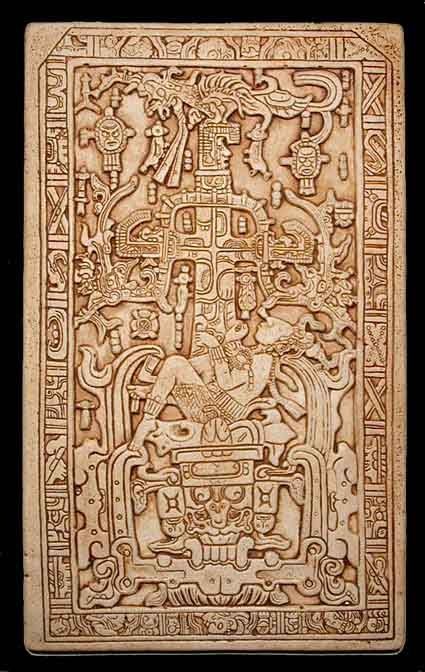
The original is still under the Temple of Inscriptions, where it was discovered in 1952. Unfortunately, archaeologists at that time were not able to translate the many symbols and glyphs on the sarcophagus. So people guessed at the meaning. One guess, in particular, proved to be very popular.
In his book, Chariots of the Gods, published in 1968, Eric Von Daniken proposed that the image on the sarcophagus actually showed an alien astronaut. Palenque was one of the ancient sites that he proposed were proof of alien presence on Earth. The book was wildly popular, selling over seven million copies. That same year, Arthur C. Clarke’s space epic, 2001: A Space Odyssey, was published. It continued a story line from his earlier work, “The Sentinel,” written in 1951, which tells the story of an ancient artifact left on the moon by alien beings. In 2001: A Space Odyssey, the obelisk proves to be the force behind the sudden advancements in human achievement, including the first use of weapons by the ape-men shown at the beginning of the movie.
So Von Danniken was simply using popular science fiction theories and imposing them on specific ancient sites, including, among others, Machu Pichu, Nazca, Cusco, and Palenque. The problem is now that experts can read Mayan glyphs and understand Mayan cosmology, people still want to see a picture of an alien astronaut on Pakal the Great’s tomb.
When I was walking from the ruins to the museum, I passed numerous street vendors offering small replicas of Pakal’s tomb lid, one of which I bought for ten dollars. But the vendor also held the plaque up sideways and pointed out the alien astronaut, in case that’s what I wanted.

The hoax is extraordinarily long-lived. Maybe it’s the appeal of seeing intelligent aliens as part of our history. TV shows like “Ancient Aliens,” “In Search of Aliens,” “Mystery Quest,” and “History’s Mysteries” keep the story of the alien astronaut alive and well. For an episode of “Ancient Aliens,” Paul Francis, a model maker, created a 3-D image of the alien astronaut on Pakal’s tomb lid. (See photo, above.) He admitted, “I had to be a little interpretive.” I guess so! The “rocket” he created looks nothing like the image on the sarcophagus.
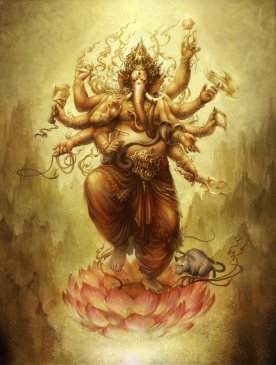

This whole debate arose out of ignorance of the belief system and cultural symbols of the ancient Maya. It would be like seeing a photo of the Indian god Ganesh (See image, above) and trying to interpret it with no knowledge of the Hindu beliefs behind it. Or looking at the image from the Book of Kells, the beautiful illuminated gospels drawn on calfskin in Ireland around 800 AD, without an understanding of the Four Evangelists it pictures and their winged representations. (That would be clockwise from the top left: Mathew – shown as a winged man, Mark – shown as a winged lion, John – shown as an eagle, and Luke – shown as a winged ox.) These symbols come from the prophetic Revelation of St. John.
Imagine the wild theories you could come up with if you didn’t know the background.
Maya symbols and cosmology
The World Tree
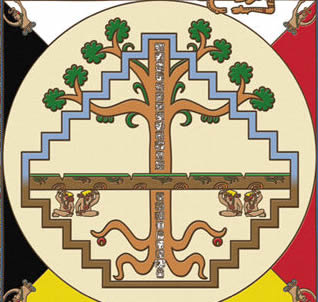
As it turns out, Maya cosmological beliefs, many of which were absorbed from earlier cultures, were fairly consistent across the Maya city-states. They saw the world as divided into three zones: The Upper World, or the land of the gods, the Middle World, where humans live, and the Underworld, which is the realm of death. However, these realms weren’t necessarily defined as good or evil. Every part had its value.
The World Tree spanned all three worlds. Its roots were in the Underworld, its trunk in the Middle World, and its highest branches in the Other World. It took several forms, including a Ceiba tree, a stylized maize plant, and a cacao tree. The version used on Pakal’s tomb lid is also used in a mural in the Temple of the Foliated Cross at Palenque.
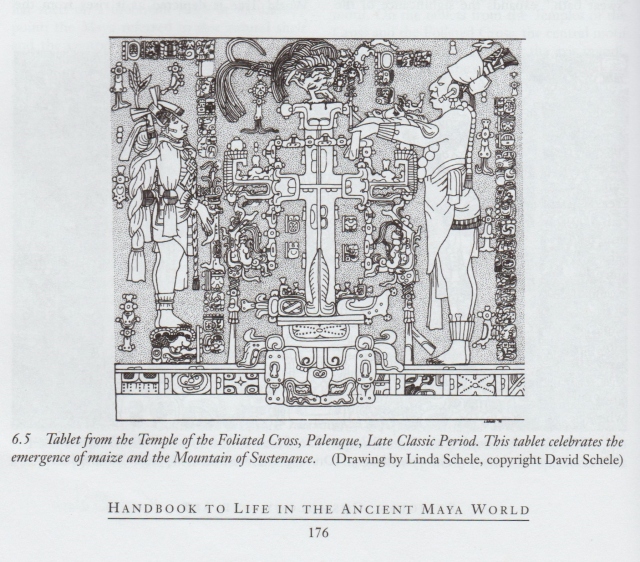
Here you see the same imagery (minus the reclining human): the World Tree rising from the offering bowl (marked with the dotted X “kin” sign and filled with the trappings of royalty: the crossed sky band, the fish, and the lancet for ritual blood-letting) on top of the Underworld/realm of the dead (Cauac monster head). At the top of the tree is the Principal Bird Deity.
Shining Glory
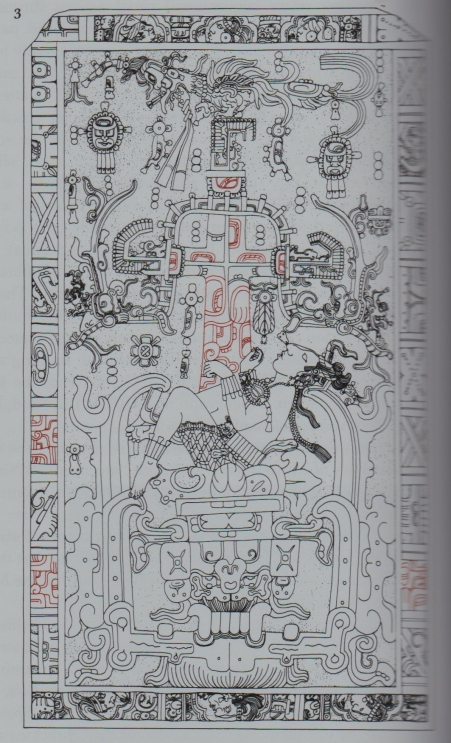
All along the tree you find the symbol for precious greenstone celts, emphasizing wealth and power as well as shining glory. (In the diagram the glyphs for jade celts are marked in red) The tree is also marked with the sign for wood.
Curled around the upper section of the tree is the Milky Way conflated with the double-headed serpent bar, which was the symbol of power for Maya kings. (See diagram below. Each serpent has a huge upper jaw.)
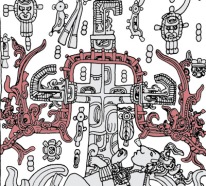
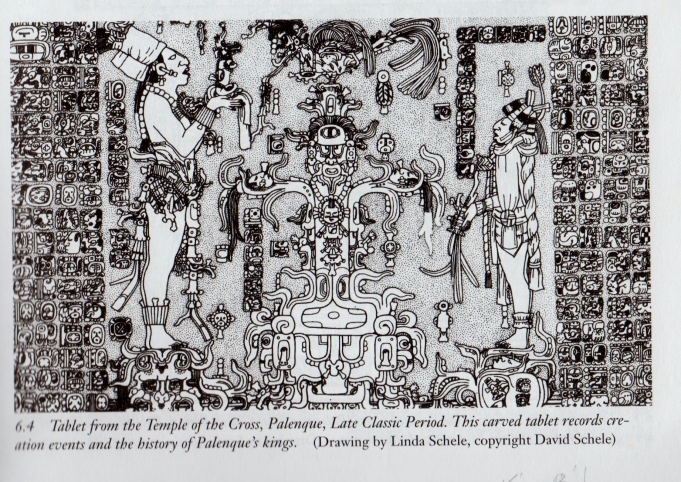
It’s interesting to see the same elements repeated in other tablets and murals which show the World Tree in the center, growing out of the Earth Monster/ Underworld. In the case of the Temple of the Cross (drawing above), the World Tree is a maize plant, with personified ears of corn growing out of the branches. Once again, it grows out of the Cuauc Monster/Underworld figure at the bottom, and the Principal Bird Deity rests at the top. Interestingly, the two figures in the mural are the same person at different ages. Note that the figure on the right stands on a personified maize plant, while the one on the left stands on a Cuauc monster with a cleft head from which corn emerges.
The King Dying and the Young Maize God Being Reborn
Pakal, on his tomb lid, is presented as both the man dying, falling into the maw of the Underworld (between jaguar jawbones) and the baby being born onto the Tree of Life. Certain Maya rulers were thought to take on the role of god-kings who could intercede with the spirit world after death. In this image, Pakal is being reborn as the maize god. (Note the seed and leaf image just below the reclining figure of Pakal.) Just as the maize seed must be buried in the earth in order to grow, Pakal is falling into the Underworld only to rise again.
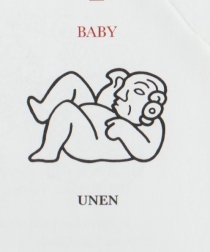

The Baby
Pakal is shown lying on his back, with the right leg raised, which is the sign for “unen” or baby (drawing on left). While this sign usually shows an infant, it’s also used to show the birth of the maize god on a Late Classic vase (drawing on right).Note the vegetation growing out of the cleft head of the Cuauc monster.

The jade skirt
Pakal’s net jade skirt is interesting in that the diamond weave is usually associated with women. Indeed, a very similar skirt seems to be worn by Pakal’s mother in a tablet found in the royal palace. (See drawing, left) This may suggest an androgynous combination, just as the adult in the baby pose suggests a combination of youth and age.
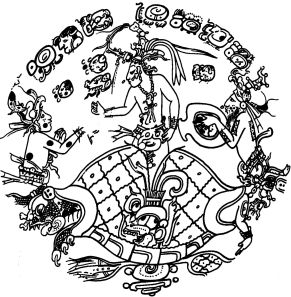

The turtle emblem
The turtle emblem Pakal carries on his chest (drawing by Linda Schele, left) may be a reference to the rebirth of the Maize God from the Turtle Shell, as referenced on this plate (drawing above, right).:
Ancestors and nobles
All along the border on the outside of the image are references to celestial bodies and six portraits of leading nobles. The coffin inside the sarcophagus is carved on all four sides with portraits of Pakal’s ancestors emerging as trees sprouting from the earth. Painted stucco figure on the walls of the tomb echo these references to relatives and important figures in the life of the leader who was laid to rest in the tomb.
Thoughts
While some may find it harmless fun to see an alien astronaut instead of a famous leader immortalized by his tombstone, for me, it seems a little insulting to the people who created this amazing piece of complicated and beautiful art.
See also It’s Not An Alien Astronaut, Part II: Bloodletting, Sacrifice, and Rebirth
Sources and interesting reading:
“Alien Explorations: Ancient Aliens season 1, episode 4,” http://alienexplorations.blogspot.com/2012/02/pacal-votan-tomb-lid-ancients-aliens.html
“Alien Explorations: Von Daniken’s Mayan Rocket Man,” http://alienexplorations.blogspot.co.uk/1979/02/von-danikens-mayan-rocket-man.html
“The Book of Kells,” The Library of Trinity College, Dublin. https:///www.tck.ie/library/manuscripts/book-of-kells.php/
Coe, Michael D. The Maya. New York: Thames and Hudson, 1999.
Four evangelists, from The Book of Kells, Public Domain, http://commons.wikimedia.org/w/index/php?curid+4013150
Fields, Virginia M. and Dore Reents-Budet. Lords of Creation: The Origins of Sacred Maya Kingship. Los Angeles County Museum of Art, Scala Publishers: 2005.
Foster, Lynn V. Handbook to Life in the Ancient Maya World. Oxford: Oxford University Press, 2002.
“Ganesh,” Manas: Indian Religions, Ganesh. https://www.sscnet.ucla.edu/southasia/Religions/Avatars/Ganesh.html
Guenter, Stanley. “The Tomb of K’inich Janaab Pakal: The Temple of the Inscriptions at Palenque,” Southern Methodist University, http://www.mesoweb.com/articles/guenter/Tl.pdf/
Heyworth, Robin, “Chicanna Structure II: The Monster Mouth Temple,” Uncovered History (blog) 16 July 2016. http://uncoveredhistory.com/mexico/chicanna/chicanna-structure-ii-monster-temple/
“K’inich Janaab’ Pakal,” Wikipedia, https://en.wikipedia.org/wiki/Kinish_Jannab’_Pakal
The Linda Schele Drawings Collection, FAMSI. http://research.famsi.org/schele_list.php?rowstart=150&search=125&title=Schele%20Drawing%20Collection&tab=schele&sort=
Mark, Joshua. J. “K’inich Janaab’ Pakal,” Ancient History Encyclopedia. http:///www.ancient.eu/Kinich_Janaab_Pacal/
Martin, Simon, and Nikolai Grube. Chronicle of the Maya Kings and Queens: Deciphering the Dynasties of the Ancient Maya. London: Thames and Hudson, 2000.
Miller, Mary, and Simon Martin. Courtly Art of the Ancient Maya. Fine Arts Museums of San Francisco, Thames and Hudson, 2004.
Minster, Christopher, “The Sarcophagus of Pakal,” Latin American History, About.com. http://latinamericanhistory.about.com/od/Maya/fl/The-Sarcophagus-of-Pakal.htm
“Pacal’s Rocket,” Ancient Aliens Debunked (blog) http://ancientaliensdebunked.com/references-and-transcripts-pacals-rocket/
Palenque: History, Art and Monuments, booklet, reproduced and authorized by the National Institute of Archaeology and History (INAH) 2001.
“Palenque Mexico,” Mayan Ruins: The Ultimate Guide of the Mayan Ruins.” http://mayanruins.info/mexico/palenque-mexico/
“The Sentinel (short story)” Wikipedia, https://en.wikipedia.org/wiki/The_Sentinel_(short_story)
Stone, Andrea, and Marc Zender. Reading Maya Art: A Hieroglyphic Guide to Ancient Maya Painting and Sculpture. New York: Thames and Hudson, 2011.
Tedlock, Dennis. 2000 Years of Mayan Literature. Berkeley: University of California Press, 2010.
“The World Tree: A World in Layers,” Mayan Kids, http://www.mayankids.com/mmkbeliefs/worldtree.htm
Many thanks for this debunking of alien astronauts in Mayan artifacts. I agree. It’s insulting to an ancient people to propose aliens had to have inspired them to do what they did.
Thanks, Ron. My feelings exactly.
My untutored first impression is (land has been for many years) that the image represents a human sacrifice and its nourishment of the World Tree. First, we see immediately that this looks like a knife or sword that is being plunged into the man’s abdomen and showing the consequent spurting of blood from the man;’s abdomen (and the secondary spillage from the altar stone). Next we see foliage on the hilt of the sword or knife. This (to me) is a wonderful wonderful conceit, wherein the sacrificial knife or sword is one and the same with the World Tree and that the knife or sword that IS the tree is causing to flow the blood that nourishes it. (Just look at the return flow of the blood to the base of the altar.) I believe Lord Pakal is saying to the gods, “Look, I have given you much good blood sacrifice that has watered the World Tree and so sustained the heavens. WELCOME ME AS A BROTHER INTO YOUR HEAVENLY REALM.”
PS Actually, and to my disgust, my room mate has this image framed and hung above the desk where I am sitting right now. I have asked her to take it down and put it away, as I am not a big fan of human sacrifice as I am neither pagan nor Christian. She refuses to take it down. Disgusting.
PPS Nice write up, even if do not agree exactly. It sure beats the grotesquely idiotic “Ancient Aliens” interpretation, Yeah, as if alien visitors were using rocket propulsion to get her.e. The nicest way to put it is lame brained. More like a way to generate book revenues .
Thanks for your thoughtful comment, Frederick. I agree that it is an image of sacrifice. However, since my main purpose in the post was to explain the problems with alien astronaut theory, I didn’t pursue the sacrifice angle. But clearly, Pacal’s bound hands make it hard to interpret the image any other way. Like Jesus for the Christians, Pacal becomes the sacrifice needed for the good of the world.
He becomes the maize god, buried in the earth in order to rise as the life-giving plant of his people. Many of the other versions of the World Tree found at Palenque use the maize plant itself as the World Tree.
It’s a beautiful and fascinating piece of work.
I have a replica over my stove!
This was an excellent presentation. however, I found no evidence that debunks anything. just another opinion, but good job!
The more you learn about Maya cosmology, the more you’ll see in this image.
Pingback: Occam’s Razor and ‘Chariots of the Gods’ – Out of Babel
I too was initially enthralled by the concept of aliens visiting and bringing advanced technology. However, when I studied ancient cultures in Central and South America I was struck by how much they were simply ignored by the folks who write American history books for school children. So of course all these beautiful ruins seemed impossible to explain except as the work of aliens. I would encourage everyone to go to the ancient sites and learn about them. Learn about the kings and queens who are immortalized in the monuments. Learn about the world view of the people who lived then. We can now decipher most of the Mayan glyphs and read the story recorded in them. It’s fascinating.
Pingback: King Pakals Tomb, Not A Spaceship.. – Stijn van den Hoven
I watch those “ancient alien” shows for the unintentional comedy, but they can get really annoying, such as when an image like this one is described as “this can ONLY be” whatever alien fantasy the speaker is claiming. I suspect that these people consider themselves very open-minded (often a euphemism for empty-headed), but declaring that something can ONLY be whatever the speaker is declaring it to be is the epitome of close-mindedness. Another recent example is the puffy-shaped little human figurines, which are described as “this can ONLY be a person in a space suit”. Well no, it could be ceremonial armor (“Oh, but then it would be patterned on a space suit!” Again, no), or even artistic license.
Thanks for the analysis of this particular image. It makes me even more annoyed at these shows to know that there are reasonable explanations that these people are just flat-out ignoring.
the picture is someone being drained of blood. hands bound at the wrist amulets, which look connected to round bar on chest. just below back of head the blood is flowing down. he’s being drained also on opposite side on lower leg or foot.the blood is collected at the bottom. There is more to that image most people don’t see. They accept the power of suggestion.
Fair enough, you see what you see.
Trained sight or enhanced sight is…
That’s another story.
eagle one
Pingback: The Tomb of Pakal | Pseudoarchaeology
Pingback: The Diamond-Shaped Face – Out of Babel
Pingback: Ancient Earthians – A Box Of Chocolates
I love you for clearing this up. This was insanely disrespectful to the legacy of such an ancestor like The Great Pakal.
Thanks for your reply.
Pingback: Prophecy Book Links | Wild Bible Stuff
Pingback: Links to Biblical prophecy book: | Wild Bible Stuff
Well done. Thank you for your scholarly input.
Thank you!
Pingback: NO UFO Sightings Depicted in Ancient Paintings, NO UFO with Jesus, NO famous paintings with Aliens. – Isu Trikanda